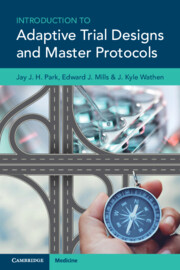Book contents
- Introduction to Adaptive Trial Designs and Master Protocols
- Introduction to Adaptive Trial Designs and Master Protocols
- Copyright page
- Content
- Preface
- About the Authors
- Part I Introduction and History of Clinical Trial Research
- Chapter 1 Introduction to Clinical Trial Research
- Chapter 2 History of Clinical Trial Research
- Part II Basic Ingredients for Adaptive Trial Designs and Common Types
- Part III Basic Ingredients for Master Protocols
- Part IV Case Studies of Adaptive Trial Designs and Master Protocols
- Part V A Practical Guide to Adaptive Trial Designs and Master Protocols
- Index
- References
Chapter 1 - Introduction to Clinical Trial Research
from Part I - Introduction and History of Clinical Trial Research
Published online by Cambridge University Press: 20 March 2023
- Introduction to Adaptive Trial Designs and Master Protocols
- Introduction to Adaptive Trial Designs and Master Protocols
- Copyright page
- Content
- Preface
- About the Authors
- Part I Introduction and History of Clinical Trial Research
- Chapter 1 Introduction to Clinical Trial Research
- Chapter 2 History of Clinical Trial Research
- Part II Basic Ingredients for Adaptive Trial Designs and Common Types
- Part III Basic Ingredients for Master Protocols
- Part IV Case Studies of Adaptive Trial Designs and Master Protocols
- Part V A Practical Guide to Adaptive Trial Designs and Master Protocols
- Index
- References
Summary
This chapter introduces clinical research concepts and randomised clinical trials, covering the basics and building blocks that are necessary to understand the topics of adaptive trial designs and master protocols. Clinical trials are a type of prospective experimental studies in which human volunteers receive specific interventions according to the research protocol, then are followed longitudinally over time. Clinical trials are typically conducted in a sequence (from phase I, phase IIA, phase IIB, and phase III) that builds on knowledge accumulated from non-clinical and previous clinical studies. Randomisation is a process of random assignment of clinical trial participants to one or more intervention group(s) or control group under comparison. The use of randomisation provides a sound basis for making statistical causal inference when estimating the comparative treatment effects between groups. Fixed sample trial design refers to a type of designs where the trial data is only analysed once when a priori determined sample size has been reached. Fixed sample trial designs are designed with a fixed maximum sample size, a fixed number of interventions, and a defined end to the trial. This is the most common approach to clinical trial research.
Keywords
- Type
- Chapter
- Information
- Publisher: Cambridge University PressPrint publication year: 2023



